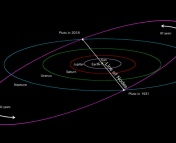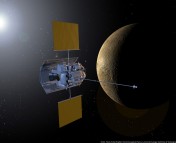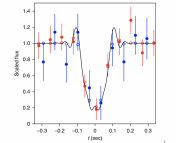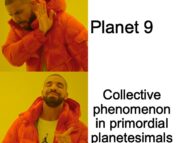Title: An early giant planet instability recorded in asteroidal meteorites
Authors: Graham Harper Edwards, C. Benhin Keller, Elisabeth R. Newton, Cameron W. Stewart
First Author’s Institution: Earth Science, Dartmouth College, 19 Fayerweather Hill Road, Hanover, 03755, NH, USA
Status: Under review at Nature Astronomy, preprint on arXiv
Evidence is mounting that planets do not stay put throughout their lifetimes. Within our own solar system, isotope signatures in meteorites require significant mixing of material from the inner and outer solar system, and the gas giants and Kuiper Belt Objects all require some amount of perturbation to explain their present day orbits. In the world of exoplanets, the population of hot Jupiters is indicative of outer giant planets migrating towards the host star, and we believe the TRAPPIST-1 planets also moved about based on their volatile abundances.
There are two main processes that can make planets migrate – interactions with the gas disk, and interactions with other planets. These mechanisms are roughly separated in time, where disk interaction would necessarily need to occur before the disk dissipates and planet interactions occur after dissipation (Figure 1). One of the primary signatures of planet migration is a period of bombardment. Planets are a major force in a solar system, and moving planets can quickly toss around smaller bodies, leading to periods of frequent collisions.
Today’s authors want to use that connection between collisions and planet migration to prove whether there was a time of giant planet migration in the early solar system!
The goal of today’s paper is to look for signs of periods of collisions in the meteorites in order to constrain when a major period of migration likely occurred. To do this, the authors use thermochronology, a way of dating meteorite samples by measuring the relative abundances of isotopes. The method relies on the idea that the abundances of isotopes retained in rock samples varies with temperature, so periods of heating through collisions would be represented as a “reset” in the isotope abundances. If a bunch of meteorites are dated to an age younger than the age of the solar system, then that might indicate a large-scale heating event like a period of bombardment!
The authors collect ages for several different meteorite classes originating from the inner solar system (Figure 2). Ages are listed relative to the formation of the solar system on the top of the plot and as time before present day on the bottom. The peaks closer to present day correspond with times that are way beyond typical estimates for giant planet migration, so the authors exclude those data points from the model. It’s likely those peaks correspond with the breakup of a massive body in the asteroid belt and some residual collisions. This leaves the major peak and tail at around 4.5 billion years ago as the data set for calculating the timing of a bombardment event.
However, figuring out the timing of such an event isn’t as simple as just locating a peak in the age data. One of the issues with the temperature-dependent aging is having to tease out effects from the thermal history of the rock itself, and additional heating from collisions that would be indicative of planet migration. To address this, the authors use a Bayesian model which includes both heating and cooling for a single body without interactions, and the heating from impacts. Parameters within the model include the material and chemical properties of the asteroid and the start time and flux of objects during bombardment. The authors then compare the ages predicted by the model to the ages collected from meteorites in Figure 1. Figure 3 shows the effects of different bombardment parameters on the fit between the model and data. As you can see, most of the peak in age comes from inherent heating of the samples.
From the modeling, the authors find that the best explanation for the shape of the meteorite age distribution is a history with two main bombardment events (like panel c in Figure 3). One event would be “primordial,” due to initial accretion and formation of the asteroids, and is likely not related to planet migration. However the second event would occur after the formation, and corresponds with a short and more intense burst of collisions. This is consistent with what you might expect from a population of asteroids stirred up by giant planet migration!
The models provide a range of possible times for a period of giant planet migration, and the authors find that the bulk of likely timings are past the dissipation of the gas disk. This is interesting because it means the planet migration and resulting bombardment were likely the result of planet instabilities as opposed to interactions with the disk.
Overall, this imprint of migration and collision on the meteorite record is really remarkable! The authors explain that more complex models for heating would help refine their conclusions, but even beginning to piece together evidence for early solar system evolution is exciting and a good motivation to learn more about the early dynamics of planet formation and its long-lasting effects.
Astrobite edited by: Roel Lefever
Featured Image Credit: NASA/JPL, NASA/FUSE/Lynette Cook




